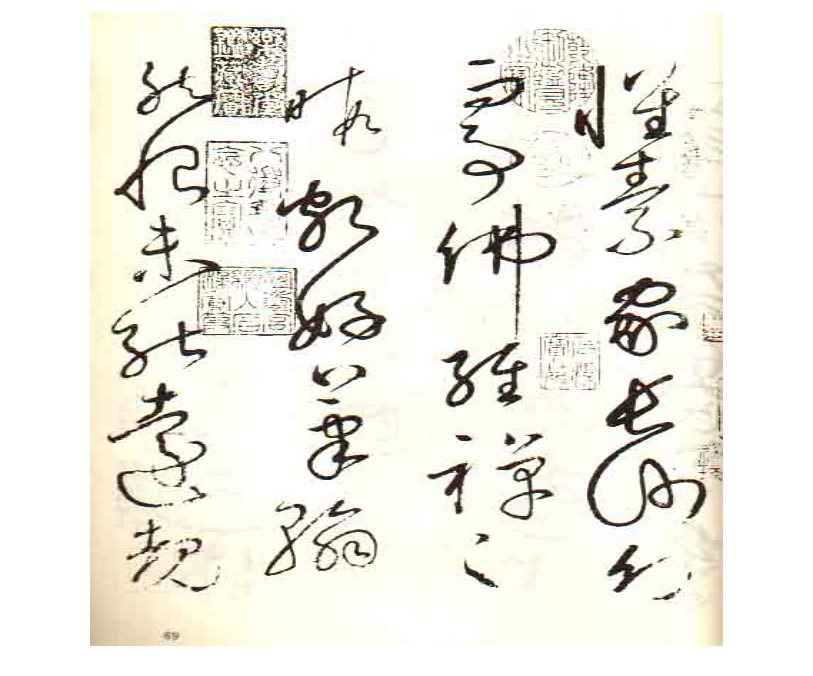Calligraphic Dances Nai-Ni Chen Dance Company

 Recently, I have heard people talking about dance work being “calligraphic”. I think they mean calligraphy as a two dimensional design, as in “lettering”. This is far from the Chinese/Japanese/Korean understanding of the highly influential form of art of Chinese Calligraphy. How ironic, Calligraphy is the art form that unifies all aspects of Chinese Art and regarded as the art form supreme in Chinese culture.
Recently, I have heard people talking about dance work being “calligraphic”. I think they mean calligraphy as a two dimensional design, as in “lettering”. This is far from the Chinese/Japanese/Korean understanding of the highly influential form of art of Chinese Calligraphy. How ironic, Calligraphy is the art form that unifies all aspects of Chinese Art and regarded as the art form supreme in Chinese culture.
In my observation, there are 3 major differences:
1. The Chinese written language is pictographic and based on natural forms. This means calligraphy has relationship to literary meaning. Lettering has no such relationship..
2. The brushstroke by the calligrapher is typically done in one continuous shot with no modifications unlike a painting or design. It is more like an action painting but with lots more attention to meaning, space and flow in the process.
3. The traces left on the paper by the brush ink is a 2 dimensional rendering of the 3 dimensional brush, which means calligraphy is really an art of motion in 3 dimensions. You can often see a Chinese viewer in a calligraphic exhibit moving their bodies with the art work. This was the beginning inspiration for Nai-Ni Chen’s Calligraphy dances.
** In Chinese art history: Huai Su, a maniacal Buddhist monk devoted to cursive script, and Yan Zhenqing, a Confucian government official and renowned calligrapher discussed the art form in the following story:
Zhenqing asked: “Do you have your own inspiration?” Su answered: “I often marvel at the spectacular summer clouds and imitate them …… I also find the cracks in a wall very natural.” Zhenqing asked: “How about water stains of a leaking house?” Huai Su rose, grabbed Yan’s hands, and exclaimed: “I get it!”
This conversation has virtually defined the aesthetic standard of the Chinese calligraphy thereafter and the “house leaking stains” and “wall cracks” became a golden measure of the skill of a calligrapher and the quality of his work. Ironically, a consensus on the interpretation of Huai Su’s “eureka” moment and the true aesthetic meaning of the three visuals has never been reached.
Summer clouds, the cracks in a wall, and water stains are formed by different physical processes: turbulent diffusion for clouds, bound breaking for fractures, and self-organizing flow (similar to a meandering river) and wetting of a surface for the water stain. The only visual characteristic they have in common is randomness.
In the process of making Calligraphy series, Nai-Ni Chen met the one of the greatest contemporary Chinese calligrapher, FangYu Wang who proposed that the goal of the calligrapher is to “resonate with the miracle of nature”. His words alluded to an energy interpretation that Nai-Ni Chen made of the three visions in her choreographic process.
The 30th Anniversary of the Nai-Ni Chen Dance Company will begins with Calligraphy II, a work inspired by “Autobiographyof Huai Shu”, done in 777 AD. The calligraphic work is well known because it created a revolution in Chinese Art that is still being actively studied today, more than a thousand years later. The calligraphic work is a record of the artist’s passion and meticulous attention to form, balance and style, yet it breaks the boundary of tradition in bringing a sense of chaos in the composition alongside of orderly strokes but consistently resonates with natural form and inspires motion.
To prepare for Calligrpahy II, Nai-Ni Chen must coach each dancer to make detailed observation of the brushwork and their relationship to the breath and flow. These observations can then be translated to to guide the motion of their limbs like a calligrapher rendering the artwork in one stroke. To reflect the order and chaos characteristic of Huai Su’s calligraphy, she made dynamically changing group formations that created flow in the fixed space of the theater that keeps the audience wonder where the next group action may occur.
So come and join us, and experience the swift wind dispersing the summer clouds, the deliberate and controlled cracks on the wall and the mysterious powerful water stain that seeps through the strongest foundation.
To get your tickets, visit Nai-Ni Chen’s website.
Fractal Expression in Chinese Calligraphy by Yuelin Li
Nai-Ni Chen Dance Company 30th Year Anniversary Celebration
New York Live Arts
219 W. 19th St.
New York, NY 10011
Thursday, December 5 at 7:30 PM
Friday, December 6 at 7:30 PM
Saturday, December 7 at 7:30 PM
Sunday, December 8 at 2 PM